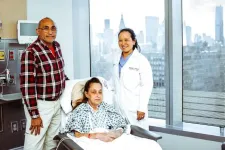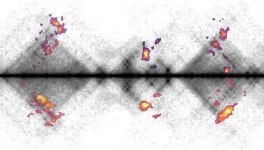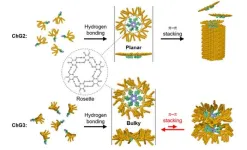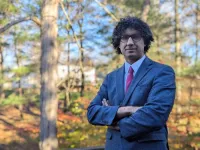(Press-News.org) NEW YORK, NY, NOV. 21, 2024—A surgical team at NYU Langone Health has performed the first fully robotic double lung transplant in the world. The procedure marks a breakthrough in the potential of robotic surgery and minimally invasive patient care, making NYU Langone the new leader in robotic transplant surgery around the globe.
Stephanie H. Chang, MD, associate professor in the Department of Cardiothoracic Surgery at NYU Grossman School of Medicine and surgical director of the Lung Transplant Program for the NYU Langone Transplant Institute, led the minimally invasive procedure. Her team transplanted both lungs into a 57-year-old woman with chronic obstructive pulmonary disease (COPD) using the da Vinci Xi robotic system at each stage. Small incisions were made between the ribs then the robotic system was used to remove the lung, prepare the surgical site for implantation, and implant the new lung. Both lungs were transplanted using these robotic techniques.
Multimedia Materials Available
Multimedia materials, including photos and a B-roll package, are available for download.
The transplant was performed on Oct. 22, 2024, just four days after patient Cheryl Mehrkar was added to the lung transplant list following several months of evaluation by Jake G. Natalini, MD, assistant professor in the Department of Medicine’s Division of Pulmonary, Critical Care and Sleep Medicine, and Luis F. Angel, MD, medical director of lung transplantation for the NYU Langone Transplant Institute. Dr. Chang was assisted by Travis C. Geraci, MD, assistant professor in the Department of Cardiothoracic Surgery, and Eugene A. Grossi, MD, the Stephen B. Colvin, MD, Professor of Cardiothoracic Surgery.
“I’m so grateful to the donor and their family for giving me another chance at life,” said Mehrkar. “For a long time, I was told I wasn’t sick enough for a transplant. The team at NYU Langone Health centered my quality of life as a priority, and I’m so grateful to the doctors and nurses here for giving me hope.”
Mehrkar, who inherited a genetic predisposition to lung disease, was diagnosed with COPD in 2010 at 43 years old. Her condition worsened after a bout with COVID-19 in 2022. Throughout her life, she has been an active thrill-seeker, traveling the world as a scuba divemaster, becoming an avid motorcyclist, and earning her karate black belt with her husband, Shahin. The couple owned a dojo for over 20 years, and she had a passion for teaching before her health sidelined her. After retiring from karate, she became a volunteer emergency medical technician with the Union Vale Fire Department in Dutchess County, New York. She remains active in the department to give back to her community.
“It is one of the greatest privileges to be able to help patients return to a healthy quality of life,” said Dr. Chang. “By using these robotic systems, we aim to reduce the impact this major surgery has on patients, limit their postoperative pain, and give them the best possible outcome. It couldn’t happen here without a talented group of surgeons and an institution dedicated to moving transplantation forward.”
Just a month earlier, NYU Langone announced Dr. Chang performed the first fully robotic single lung transplant in the nation. Now her team is the global leader in lung transplantation surgery.
A Breakthrough Innovation in Transplant Surgery
“This latest breakthrough in robotic surgery speaks to the culture of innovation we’ve built by bringing the most talented people in their fields together,” said Robert Montgomery, MD, DPhil, the H. Leon Pachter, MD, Professor of Surgery, chair of the Department of Surgery, and director of the NYU Langone Transplant Institute. “Our Transplant Institute team pushes the field forward to better serve our patients and deliver the lifesaving care they need with the best patient experience.”
The NYU Langone Transplant Institute performed 76 lung transplants in 2023 and was rated best in the nation for lung survival after transplant and for getting patients off the waitlist the fastest by the Scientific Registry of Transplant Recipients, a national quality tracker overseen by the U.S. Department of Health and Human Services.
“We are grateful to have some of the most talented surgeons in the world who break barriers and push the boundaries of what is possible for our patients,” said Ralph S. Mosca, MD, the Henry H. Arnhold Chair of Cardiothoracic Surgery, professor in the Departments of Cardiothoracic Surgery and Pediatrics at NYU Grossman School of Medicine, and director of the Pediatric Congenital Heart Program at Hassenfeld Children’s Hospital at NYU Langone. “This latest innovation is a watershed moment in lung transplantation surgery worldwide and just the beginning of a new era in patient care.”
Surgeons at NYU Langone are international leaders in using robotic technology to manage a wide range of medical conditions, performing more than 2,000 robot-assisted surgeries each year. NYU Langone experts have pioneered the development and innovation of many robotic surgery techniques and continue to invest in new and evolving technology. As leaders in robotic surgical techniques, NYU Langone trains surgeons from hospitals across the nation and from around the world in how to perform the latest robot-assisted cardiac, bariatric, thoracic, gynecologic, colorectal, urologic, and gastrointestinal procedures.
NYU Langone Health is a world-class, patient-centered, integrated academic medical center, with a culture rooted in excellence in patient care, education, and research. Vizient, Inc., has ranked NYU Langone the No. 1 comprehensive academic medical center in the country for three years in a row, and U.S. News & World Report recently placed nine of its clinical specialties among the top five in the nation. NYU Langone offers a comprehensive range of medical services across six inpatient locations, its Perlmutter Cancer Center, and more than 300 outpatient locations across the New York area and Florida. With $14 billion in revenue this year, the system also includes two medical schools, in Manhattan and on Long Island, and a vast research enterprise.
END
NYU Langone performs world’s first fully robotic double lung transplant
2024-11-21
ELSE PRESS RELEASES FROM THIS DATE:
APSS accepting sleep and circadian research abstracts and session proposals for SLEEP 2025 in Seattle
2024-11-21
DARIEN, IL – The Associated Professional Sleep Societies is accepting research abstracts and session proposal submissions for SLEEP 2025, the 39th annual meeting of the APSS, which will be held June 8 to 11 at the Seattle Convention Center.
Research abstracts will be accepted for oral and poster presentations. Hot topics for 2025 include machine learning and artificial intelligence, metabolomics and genomics, sleep and the glymphatic system, orexin pharmacology, and obesity management. Accepted abstracts ...
DNA repair: A look inside the cell’s ‘repair café’
2024-11-21
New research from the Kind Group at the Hubrecht Institute sheds light on how cells repair damaged DNA. For the first time, the team has mapped the activity of repair proteins in individual human cells. The study demonstrates how these proteins collaborate in so-called "hubs" to repair DNA damage. This knowledge offers opportunities to improve cancer therapies and other treatments where DNA repair is essential. The researchers published their findings in Nature Communications on November 21.
DNA is the molecule that carries our genetic information. It can be damaged by normal cellular processes as well as external factors such as UV radiation ...
Astronomers take the first close-up picture of a star outside our galaxy
2024-11-21
“For the first time, we have succeeded in taking a zoomed-in image of a dying star in a galaxy outside our own Milky Way,” says Keiichi Ohnaka, an astrophysicist from Universidad Andrés Bello in Chile. Located a staggering 160 000 light-years from us, the star WOH G64 was imaged thanks to the impressive sharpness offered by the European Southern Observatory’s Very Large Telescope Interferometer (ESO’s VLTI). The new observations reveal a star puffing out gas and dust, in the last stages before it becomes a supernova.
“We discovered an ...
Here’s something Americans agree on: Sports build character
2024-11-21
COLUMBUS, Ohio – In a polarized nation, there is one thing that nearly all Americans agree on, according to a recent study: Sports are good for us.
Researchers from The Ohio State University and Ithaca College found that more than 9 out of 10 Americans agreed that sports build character and improved one’s health, while 84% agreed playing sports makes one popular in school and 85% said it makes one more well-known in the community.
According to 67% of those surveyed, playing sports even leads to better grades in school.
While these beliefs may seem harmless, ...
Engineering nature’s blueprint: Dendron-based assemblies for chlorophyll’s materials
2024-11-21
Researchers often look to photosynthesis—a process that turns sunlight into chemical energy in plants and bacteria—as a model for innovation. Photosynthesis is in turn linked to chlorophyll pigments, tiny green molecules that play a key role in harvesting light. Naturally, these chlorophyll molecules are organized into precise structures to optimize light absorption in plants and bacteria, and efficiently capture sunlight for energy. Inspired by this natural structure, scientists have explored ways to synthetically assemble chlorophyll-based ...
Study reveals how cell types shape human brain networks
2024-11-21
Rutgers researchers at the Brain Health Institute (BHI) and Center for Advanced Human Brain Imaging Research (CAHBIR) have uncovered how different types of brain cells work together to form large-scale functional networks in the human brain – interconnected systems that support everything from sensory processing to complex decision-making – paving the way for new insights into brain health and disease.
By pinpointing these cellular foundations, the study, published in Nature Neuroscience, offers a deeper understanding of the cellular foundations of cognition and mental health.
The brain’s functional properties arise from the varied ...
New genetic explanation for heart condition revealed
2024-11-21
A potentially life-changing heart condition, dilated cardiomyopathy, can be caused by the cumulative influence of hundreds or thousands of genes and not just by a single “aberrant” genetic variant, as was previously thought, finds a new study led by researchers at UCL (University College London), Imperial College London and the MRC Laboratory of Medical Sciences.
Dilated cardiomyopathy (DCM) is a condition in which the heart becomes progressively enlarged and weakened, reducing its ability to pump blood efficiently. It is estimated to affect up to 260,000 people in the UK (one in every 250 individuals) and is the leading cause of heart transplantation.
Previously, ...
Poor mental health linked to browsing negative content online
2024-11-21
People with poorer mental health are more prone to browsing negative content online, which further exacerbates their symptoms, finds a study led by UCL researchers.
The relationship between mental health and web-browsing is causal and bi-directional, according to the Wellcome-funded study published in Nature Human Behaviour.
The researchers have developed a plug-in tool* that adds ‘content labels’ to webpages—similar to nutrition labels on food—designed to help users make healthier and more informed decisions about the ...
People with migraine at high risk of depression during pandemic
2024-11-21
Toronto, ON – A recent longitudinal study from the University of Toronto reveals the mental health consequences of the COVID-19 pandemic on older adults living with migraine.
Using a sample of more than 2,000 older adults with migraine from the Canadian Longitudinal Study on Aging, researchers examined changes in depression status among this population during the pandemic. More than 1 in 7 older adults with migraine experienced depression for the first time during the COVID-19 pandemic, while approximately 1 in 2 with a previous history of depression experienced a recurrence during this period.
“People ...
Climate-driven hazards increases risk for millions of coastal residents, study finds
2024-11-21
A new study published in Nature Climate Change estimates that a 1-meter sea level rise by 2100 would affect over 14 million people and $1 trillion worth of property along the Southeast Atlantic coast, from Norfolk, Virginia, to Miami, Florida.
The study assesses the cumulative impact of multiple climate-driven coastal hazards, including sea level rise, flooding, beach erosion, sinking land, and rising groundwater, all of which are expected to worsen significantly by the end of the 21st century.
The scale of these interconnected ...






